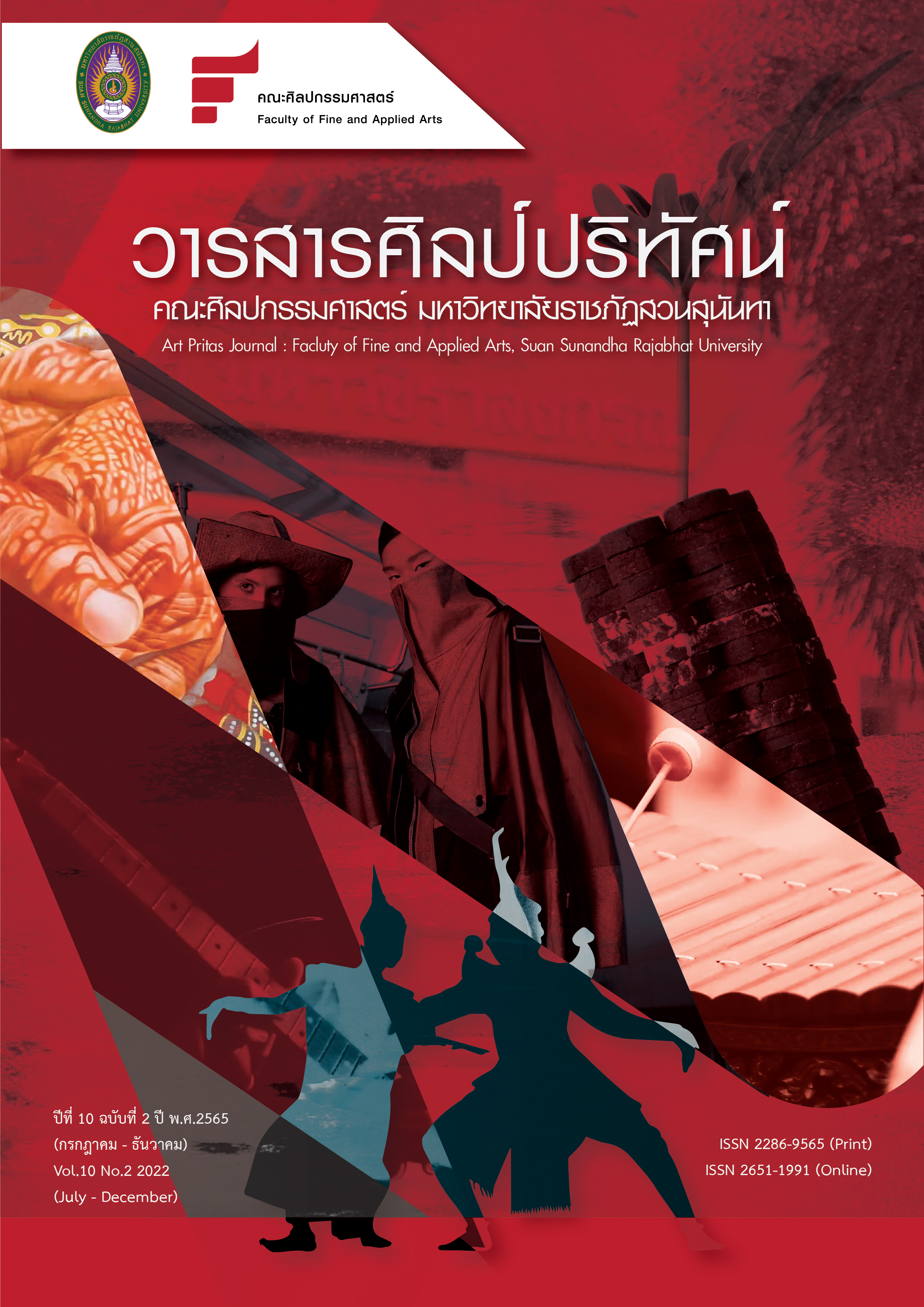อัตลักษณ์ท้องถิ่น สู่การสร้างสรรค์ประติมากรรมกลางแจ้งประกอบการออกแบบภูมิทัศน์ จังหวัดปราจีนบุรี
Main Article Content
บทคัดย่อ
การวิจัยเรื่อง “อัตลักษณ์ท้องถิ่น สู่การสร้างสรรค์ประติมากรรมกลางแจ้งประกอบการออกแบบภูมิทัศน์ จังหวัดปราจีนบุรี” มีวัตถุประสงค์เพื่อศึกษาอัตลักษณ์ของจังหวัดปราจีนบุรีในบริบททางธรรมชาติ ทางสังคม ทางศิลปะและทางวัฒนธรรม และเพื่อออกแบบประติมากรรมกลางแจ้ง ประกอบการออกแบบภูมิทัศน์ในพื้นที่ส่วนกลางภายใน อาคารศูนย์ราชการจังหวัดปราจีนบุรี ให้สอดคล้องกับอัตลักษณ์ของจังหวัดปราจีนบุรีและการใช้งาน ผู้ให้ข้อมูลในการวิจัยได้จากการเลือกตามวัตถุประสงค์ (Purposive sampling) เป็นพนักงานราชการที่ทำงานอยู่ภายในอาคารศูนย์ราชการจังหวัดปราจีนบุรี ซึ่งกำหนดตัวแทนของแต่ละหน่วยงาน 1 ท่าน เป็นหัวหน้าหน่วยงานหรือผู้แทนที่ได้รับมอบหมายจากหัวหน้าฯซึ่งจะต้องอาศัยในพื้นที่ไม่น้อยกว่า 5 ปี โดยมีหน่วยงานภายในศูนย์ราชการจังหวัดปราจีนบุรี จำนวน 16 หน่วยงาน สถิติที่ใช้ในการศึกษาวิจัย คือ ค่าเฉลี่ย
ผลการศึกษาวิจัยพบว่าอัตลักษณ์ของจังหวัดปราจีนบุรี ได้แก่ รูปร่าง รูปทรงที่มีที่มาจากพรรณไม้ ซึ่งมีที่มาจากตราสัญลักษณ์ คำขวัญของจังหวัดปราจีนบุรี และดอกไม้มงคลได้แก่ ใบโพธิ์ ลำต้นโพธิ์ ดอกปีบ ดอกจำปี ดอกจำปา และ รูปร่างรูปทรงที่มีที่มาจากอาคารสถานที่และส่วนประดับ ซึ่งได้มาจากข้อมูลที่ทำการศึกษา ได้แก่ รูปร่างรูปทรงเจดีย์ อาคารอนุรักษ์โรงพยาบาลเจ้าพระยาอภัยภูเบศรและส่วนประดับภายในอาคาร พระอุโบสถวัดแจ้ง โบราณสถานศรีมโหสถ พระพุธรูปทวารวดี เป็นลักษณะที่สะท้อนความรู้สึกถึงความเป็นอัตลักษณ์ของจังหวัดปราจีนบุรีและนำไปสู่การออกแบบภูมิทัศน์และประติมากรรมโดยผู้วิจัยนำรูปร่าง รูปทรงของใบโพธิ์มาออกแบบภูมิทัศน์เป็นแนวทางเดิน นำส่วนของใบโพธิ์ เส้นใยใบโพธิ์ และก้านโพธิ์ มาทำการออกแบบช่อโพธิ์เงิน ตะกร้อโพธิ์ทอง และสลักก้านโพธิ์ โดยประกอบกัน
ตรงส่วนบนของประติมากรรม ในผลงานประติมากรรมยังมีหอทรงเพชรจำปีหงาย หอทรงเพชรจำปาคว่ำ ได้รับแรงบันดาลใจมาจากพระอุโบสถ ณ วัดแจ้งโดยออกแบบให้มีลักษณะ รูปทรงคล้ายเพชรติดตั้งตราสัญลักษณ์จังหวัดปราจีนบุรีไว้ด้านบน นอกจากนั้นได้ใช้สิงห์ซึ่งพบตามรั้วและอาคารอนุรักษ์โรงพยาบาลเจ้าพระยาอภัยภูเบศรมาเป็นส่วนหนึ่งของงานประติมากรรมโดยติดตั้งไว้ทั้ง 4 มุมของฐานประติมากรรม แล้วตรวจสอบคุณภาพหรือการประเมินคุณภาพผลงานออกแบบ โดยใช้แบบประเมิน ประเมินด้วยวิธีเดียวกันกับการหาค่าดัชนีความตรงเชิงเนื้อหา (Content Validity Index: CVI) คุณภาพของผลงานประเด็นประติมากรรมสะท้อนอัตลักษณ์ท้องถิ่นของจังหวัดปราจีนบุรี ประติมากรรมกลมกลืนกับภูมิทัศน์ ประติมากรรมมีคุณค่าทางความงาม ประติมากรรมมีความสมบูรณ์คงทน ประติมากรรมมีรูปแบบไม่ซ้ำผลงานผู้อื่น และประเด็น ประติมากรรมแก้ปัญหาสภาพภูมิทัศน์เดิมได้ โดยสรุปทุกรายประเด็นมีคุณภาพอยู่ในเกณฑ์ที่ยอมรับได้คือ iCVI อยู่ระหว่าง 0.67-1.00 และดัชนีความเที่ยงตรงตามเนื้อหาเฉลี่ยทุกประเด็นมีค่าเฉลี่ยอยู่ที่ 0.945 มีคุณภาพผ่านเกณฑ์ที่กำหนด
Article Details

อนุญาตภายใต้เงื่อนไข Creative Commons Attribution-NonCommercial-NoDerivatives 4.0 International License.
เนื้อหาและข้อมูลในบทความที่ลงตีพิมพ์ในวารสารศิลป์ปริทัศน์ ถือเป็นข้อคิดเห็นและความรับผิดชอบของผู้เขียนบทความโดยตรง ซึ่งกองบรรณาธิการวารสารไม่จำเป็นต้องเห็นด้วย หรือร่วมรับผิดชอบใดๆ
บทความ ข้อมูล เนื้อหา รูปภาพ ฯลฯ ที่ได้รับการตีพิมพ์ในวารสารศิลป์ปริทัศน์ถือเป็นลิขสิทธิ์ของวารสารศิลป์ปริทัศน์
เอกสารอ้างอิง
กมลวัฒน์ ยะสารวรรณ. (2547). การรับรู้กฎระเบียบของพนักงานท่าเรือแหลมฉบัง. (รัฐประศาสนศาสตรมหาบัณฑิต). มหาวิทยาลัยบูรพา, บัณฑิตวิทยาลัย, สาขานโยบายสาธารณะ.
ฉัตร์ชัย อรรถปักษ์. (2550). องค์ประกอบศิลปะ (พิมพ์ครั้งที่ 2 ). กรุงเทพฯ: วิทยพัฒน์.
บุญใจ ศรีสถิตย์นรากูร. (2550). ระเบียบวิธีการวิจัยทางพยาบาลศาสตร์ (พิมพ์ครั้งที่ 4). กรุงเทพฯ: ยูแอนด์ไอ อินเตอร์มีเดีย.
บัณฑิต เผ่าวัฒนา. (2548). การมีส่วนร่วมของประชาชนในการจัดการปัญหาน้ำเสียในคลองแม่ข่า ตำบลช้างคลาน เทศบาลนครเชียงใหม่.
เชียงใหม่: บัณฑิตวิทยาลัย มหาวิทยาลัยเชียงใหม่.
ปรีชา เถาทอง. (2554). กรมส่งเสริมวัฒนธรรม. (6 ธันวาคม 2554). สัมภาษณ์.
มัย ตะติยะ. (2547). สุนทรียภาพทางทัศนศิลป์. กรุงเทพฯ: วาดศิลป์
วัฒนาพร เขื่อนสุวรรณ. (2547). การรับรู้ความงามของมนุษย์. เชียงใหม่: สถาบันเทคโนโลยี่ราชมงคลวิทยาลัยเขตพายัพ
ศุภพงศ์ ยืนยง. (2547). หลักการเขียนภาพ. กรุงเทพฯ: โอเอสพริ้นติ้งเฮ้า
อนันต์ ประภาโส. (2542). วาดเส้น (พิมพ์ครั้งที่ 1). กรุงเทพฯ : สิปประภา
อิทธิพล ตั้งโฉลก. (2550). แนวทางการสอนและสร้างสรรค์จิตรกรรมขั้นสูง. กรุงเทพฯ : อมรินทร์พริ๊นติ้งแอนด์พับลิชชิ่ง.
Edmonds, W. A. & Kennedy, T. D. (2017). An Applied Guide to Research Designs: Quantitative, Qualitative,
and Mixed Methods (2nd ed.). Singapore, SAGE Publications, Inc.


